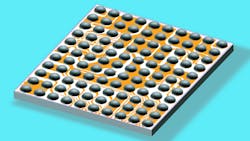50-W Qi Wireless-Charging IC Called World’s Fastest
Delivering as much as 50 W, STMicroelectronics’s STWLC88 Qi wireless-charging IC is touted as the world’s fastest Qi charging IC. The device enables consumers to charge smartphones, tablets, laptops, and other personal electronic devices without cables as safely and nearly as quickly and efficiently as they could by plugging them in. ST’s 50-W wireless-power IC charges smartphones two times faster than the previous-generation device.
Safe, wireless delivery of high power to charge personal electronics must address a range of challenges including efficiency; reliable communication; foreign-object detection (FOD); and thermal, over-voltage, and over-current protection. ST, a long-standing member of the Wireless Power Consortium that oversees the industry-standard Qi wireless power-transfer system, addresses these challenges with patented hardware, signal-processing algorithms, and its proprietary ST SuperCharge (STSC) protocol. These enhancements allow ST customers to implement a turnkey Tx/Rx solution consisting of the STWLC88 and the STWBC2 digital controller to achieve high power efficiently and safely, while remaining compliant with Qi specifications.
With its fully integrated ultra-low impedance, high-voltage synchronous rectifier, and low drop-out linear regulator, the STWLC88 achieves high efficiency and low power dissipation, critical for applications that are highly sensitive to unnecessary heat buildup. The power-charger chip features dedicated hardware and advanced algorithms that were developed to address challenges in ASK and FSK communication during high power delivery. Moreover, the STWLC88 comes with highly accurate Foreign Object Detection (FOD) and an integrated accurate current-sensing system to ensure high power delivery is performed safely and in a controlled manner.
The STWLC88 can also operate in high-efficiency transmitter mode to allow high-power charge-sharing mode. This is coupled with the STWLC88’s industry-first Q factor detection in a receiver device to ensure safe operation and protection to end users.
An I2C interface allows firmware and platform developers to customize parameters in the device and the configuration can be programmed into the embedded FTP, which allows for more than 1000 times of re-programming. Additional firmware patching improves the IC’s application flexibility.
The STWLC88 incorporates multiple circuits to substantially reduce the external BOM (bill of materials), making it ideal for integration in a wide range of applications with restrictive PCB area requirements. Being WPC Qi 1.2.4 EPP compliant, the STWLC88 is fully compatible with all Qi EPP certified transmitters in the market. As a result, the STWLC88 offers state-of-the-art features that are critical for performance and safety and is ideal for medium- to high-power wireless-charging applications.
The STWLC88 is in production and available in a 4.0mm x 4.5mm x 0.6mm WLCPS 110-bump, 0.4-mm pitch package, priced from $2.50 for orders of 10,000 pieces.
The STEVAL-ISB88RX evaluation board, containing the STWLC88 and a sophisticated GUI, is also available to simplify prototyping and significantly cut time to market with the 50-W charger IC.
STMicroelectronics, www.st.com
About the Author
David Maliniak
Executive Editor, Microwaves & RF
I am Executive Editor of Microwaves & RF, an all-digital publication that broadly covers all aspects of wireless communications. More particularly, we're keeping a close eye on technologies in the consumer-oriented 5G, 6G, IoT, M2M, and V2X markets, in which much of the wireless market's growth will occur in this decade and beyond. I work with a great team of editors to provide engineers, developers, and technical managers with interesting and useful articles and videos on a regular basis. Check out our free newsletters to see the latest content.
You can send press releases for new products for possible coverage on the website. I am also interested in receiving contributed articles for publishing on our website. Use our contributor's packet, in which you'll find an article template and lots more useful information on how to properly prepare content for us, and send to me along with a signed release form.
About me:
In his long career in the B2B electronics-industry media, David Maliniak has held editorial roles as both generalist and specialist. As Components Editor and, later, as Editor in Chief of EE Product News, David gained breadth of experience in covering the industry at large. In serving as EDA/Test and Measurement Technology Editor at Electronic Design, he developed deep insight into those complex areas of technology. Most recently, David worked in technical marketing communications at Teledyne LeCroy, leaving to rejoin the EOEM B2B publishing world in January 2020. David earned a B.A. in journalism at New York University.

